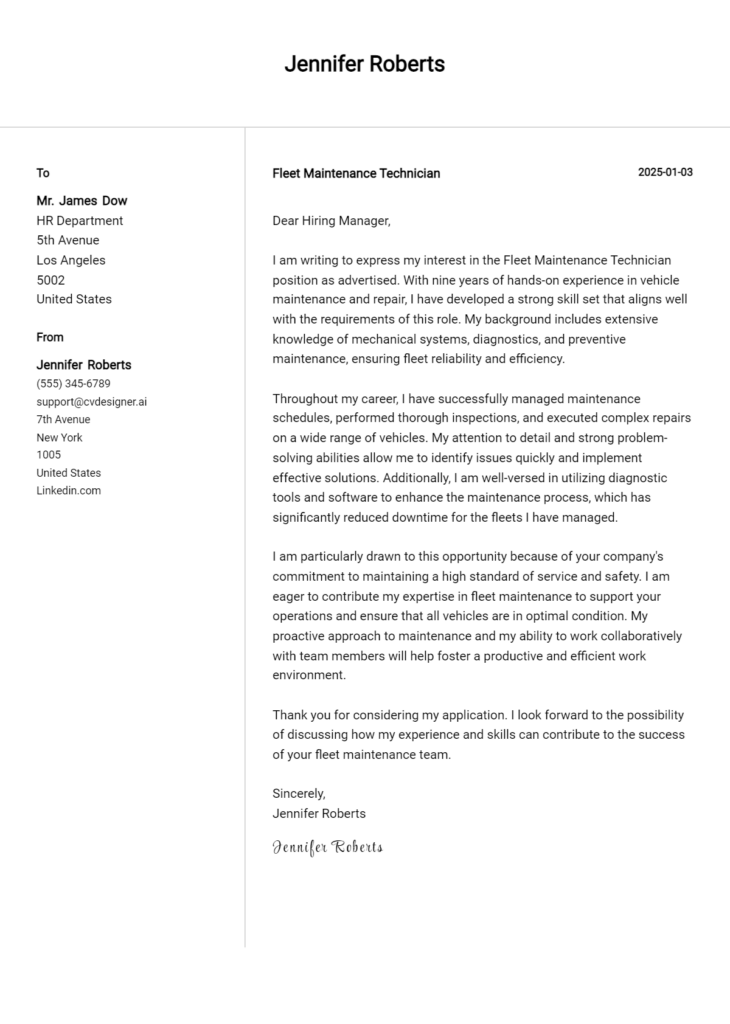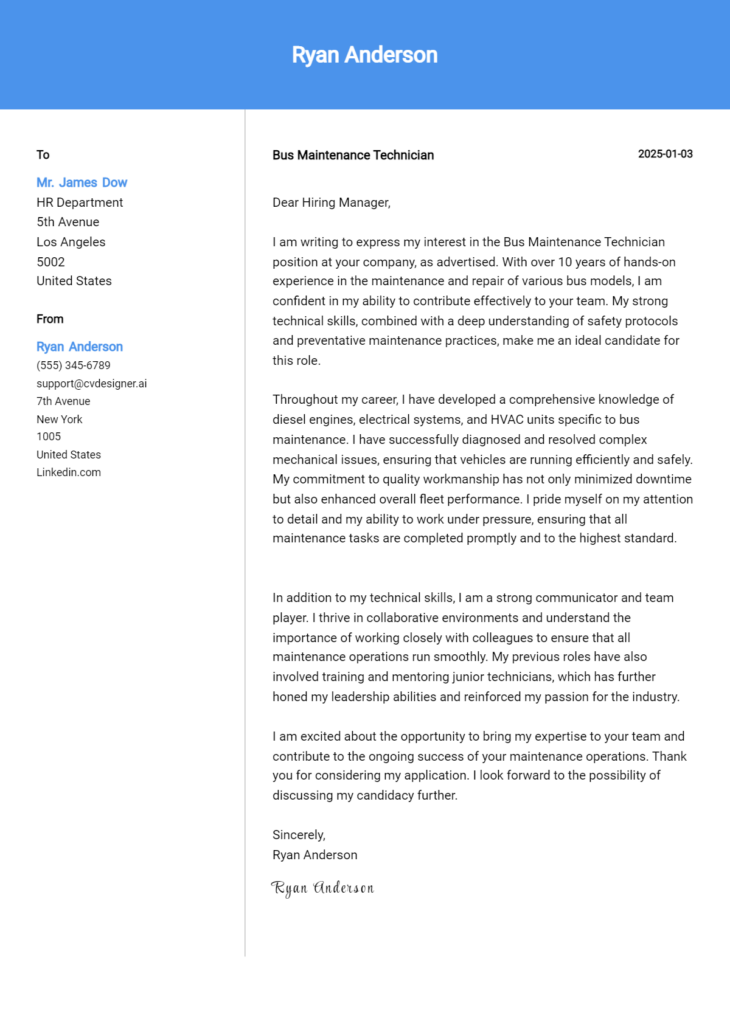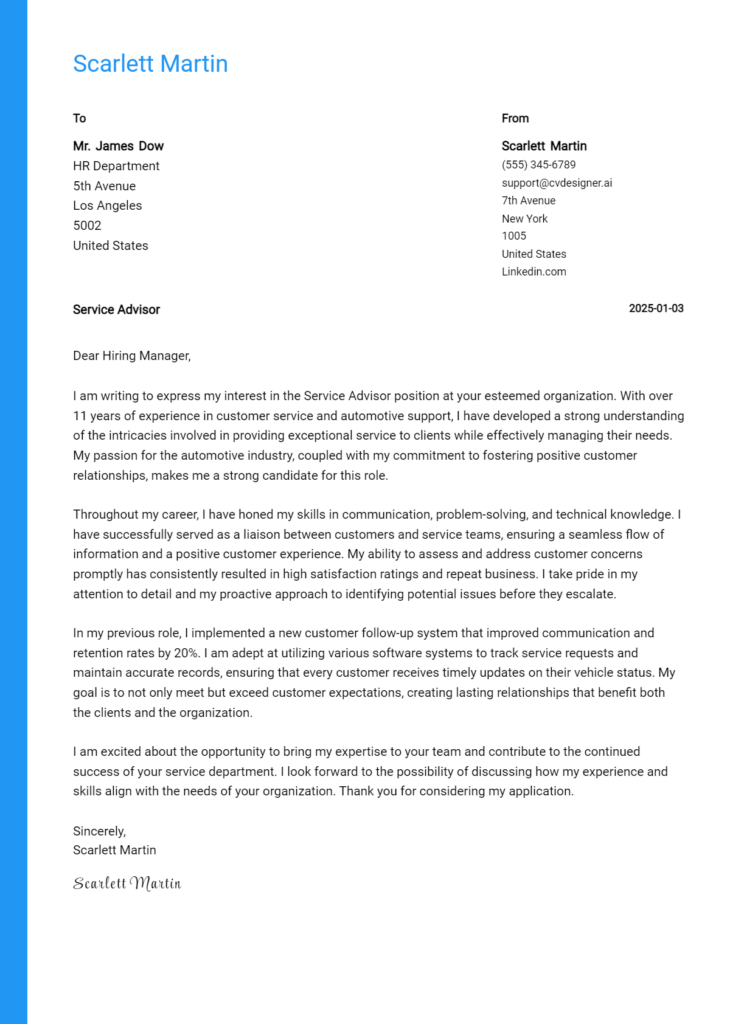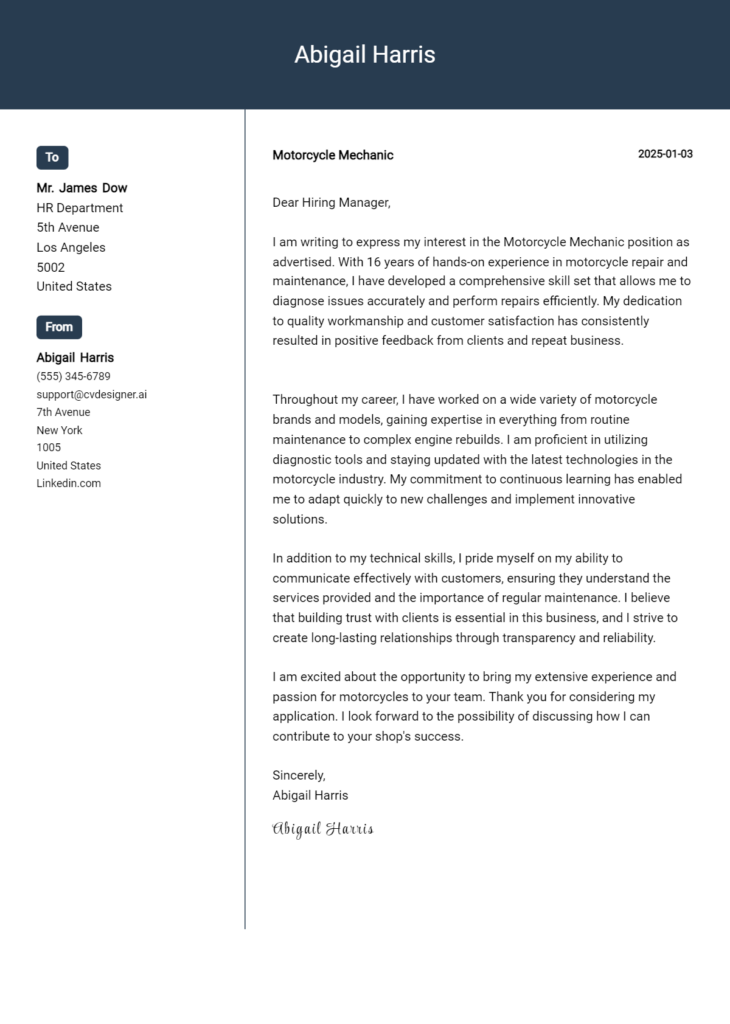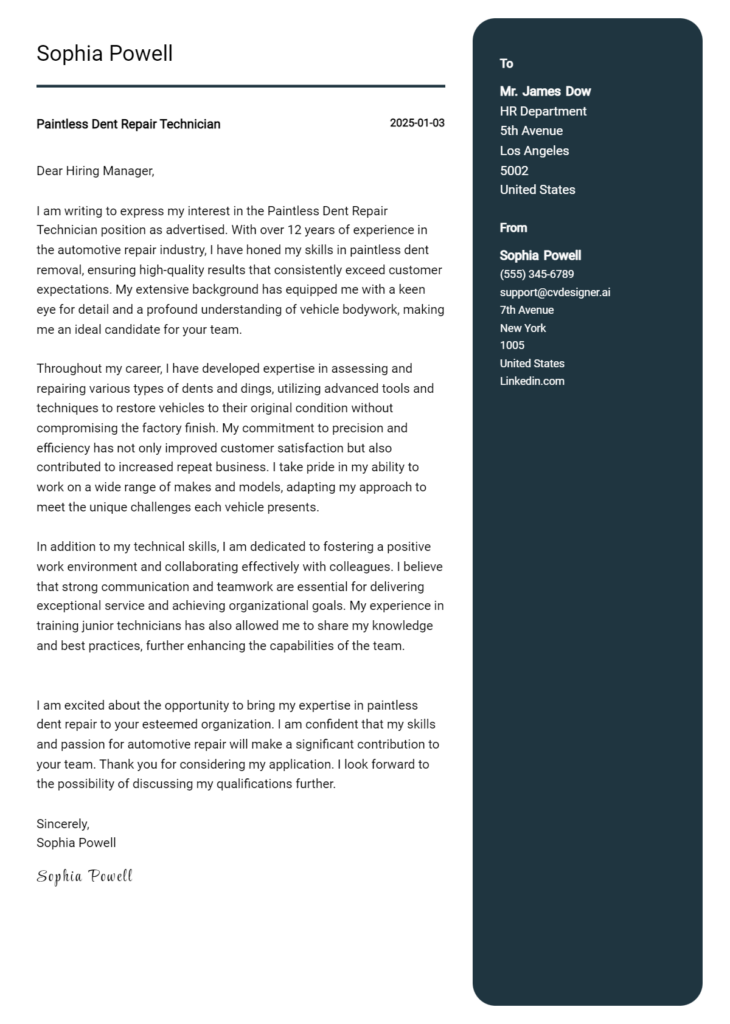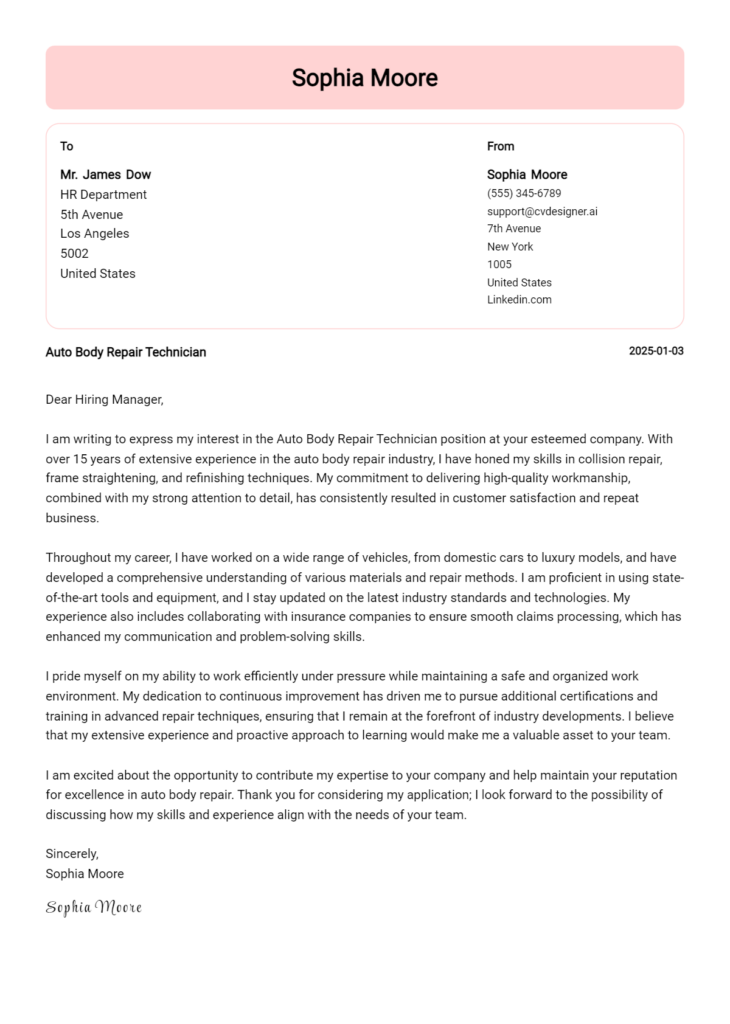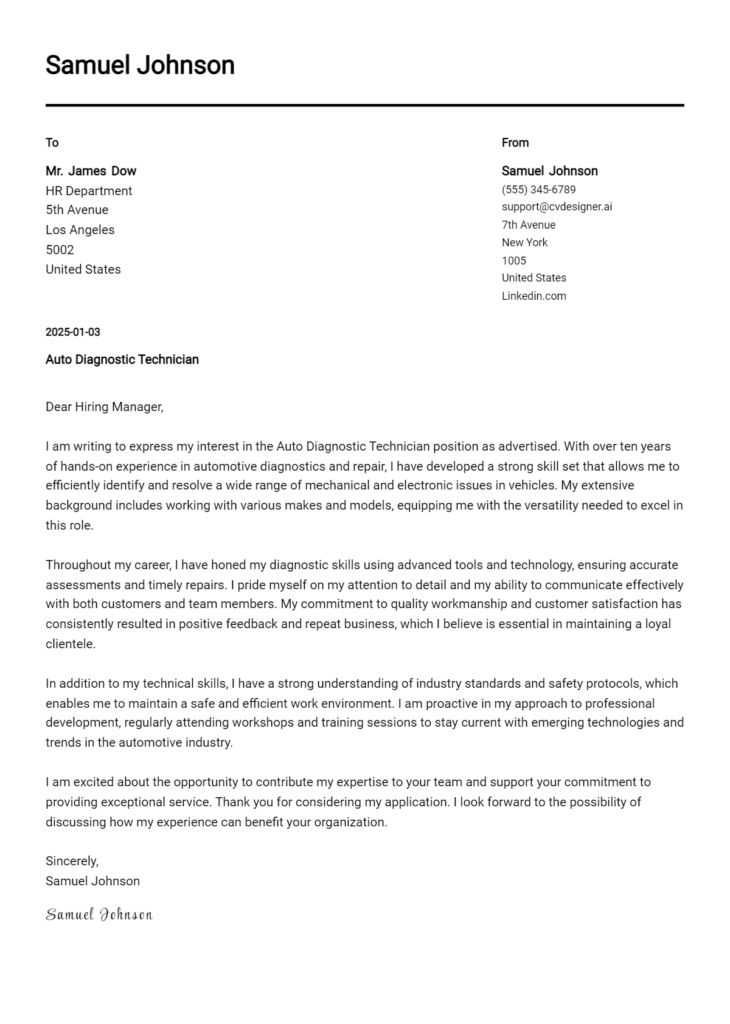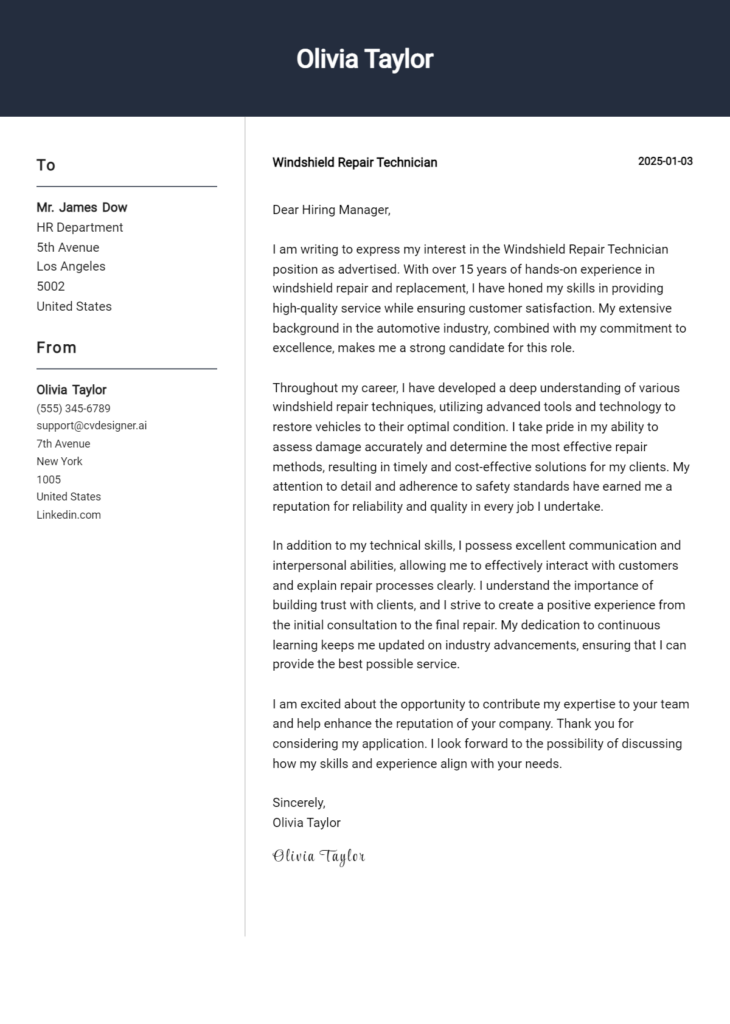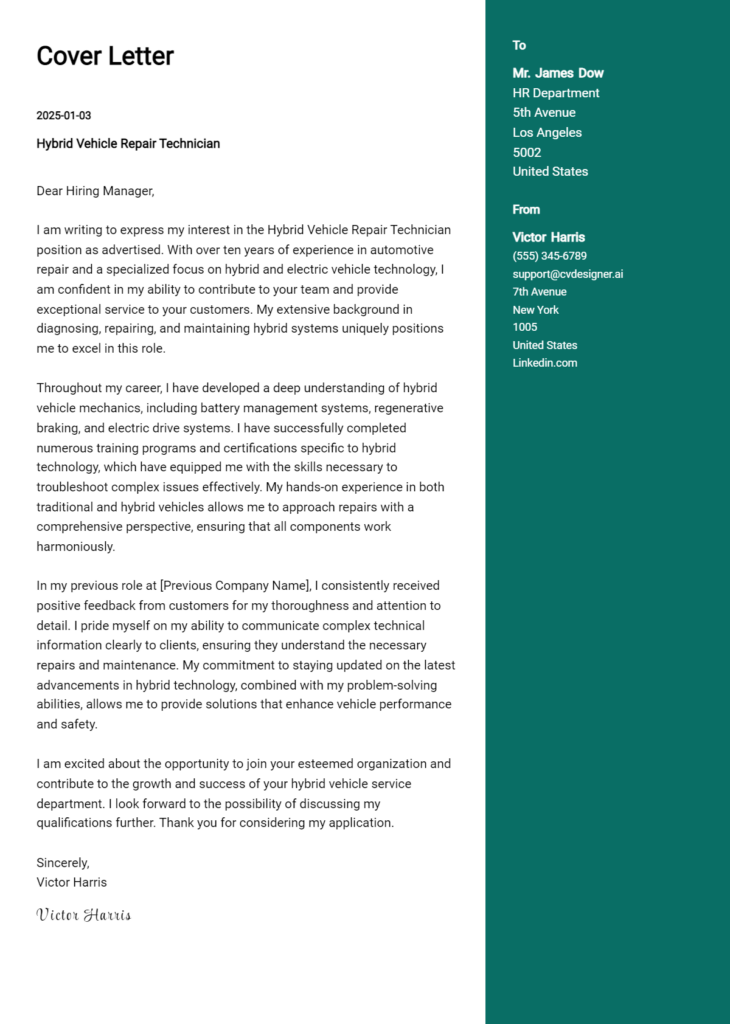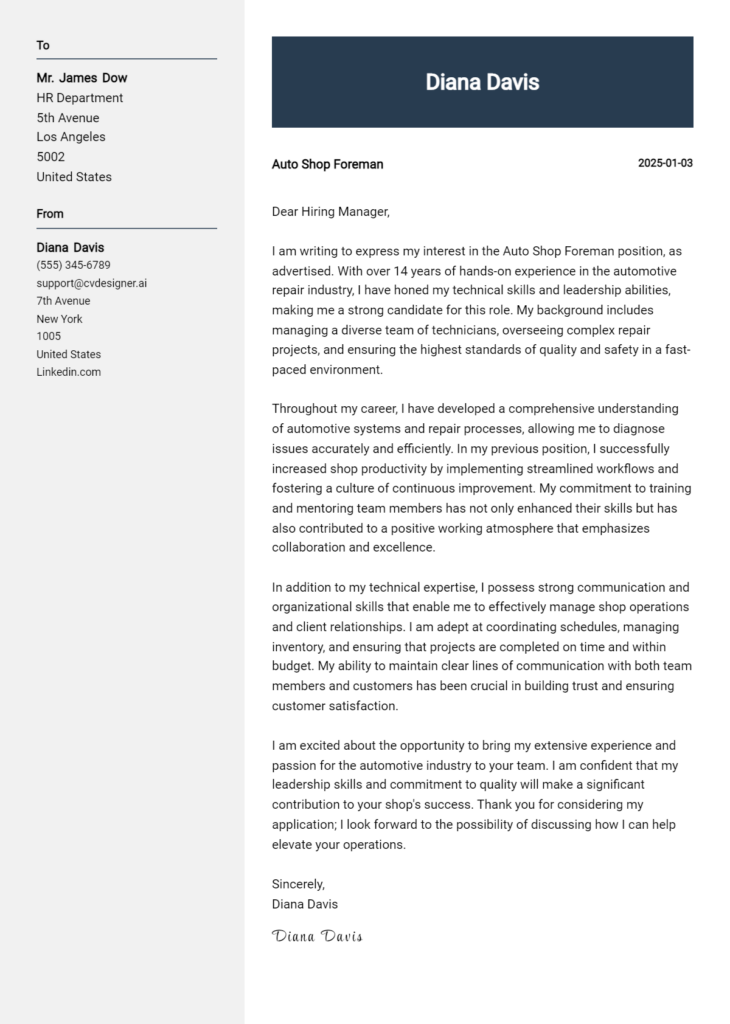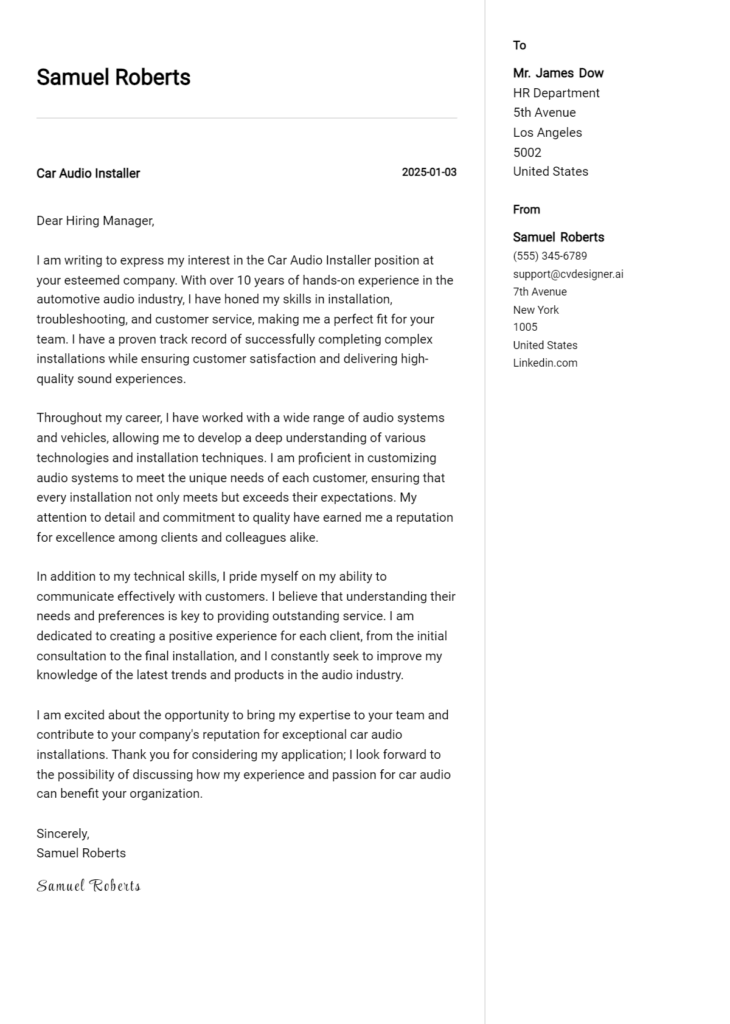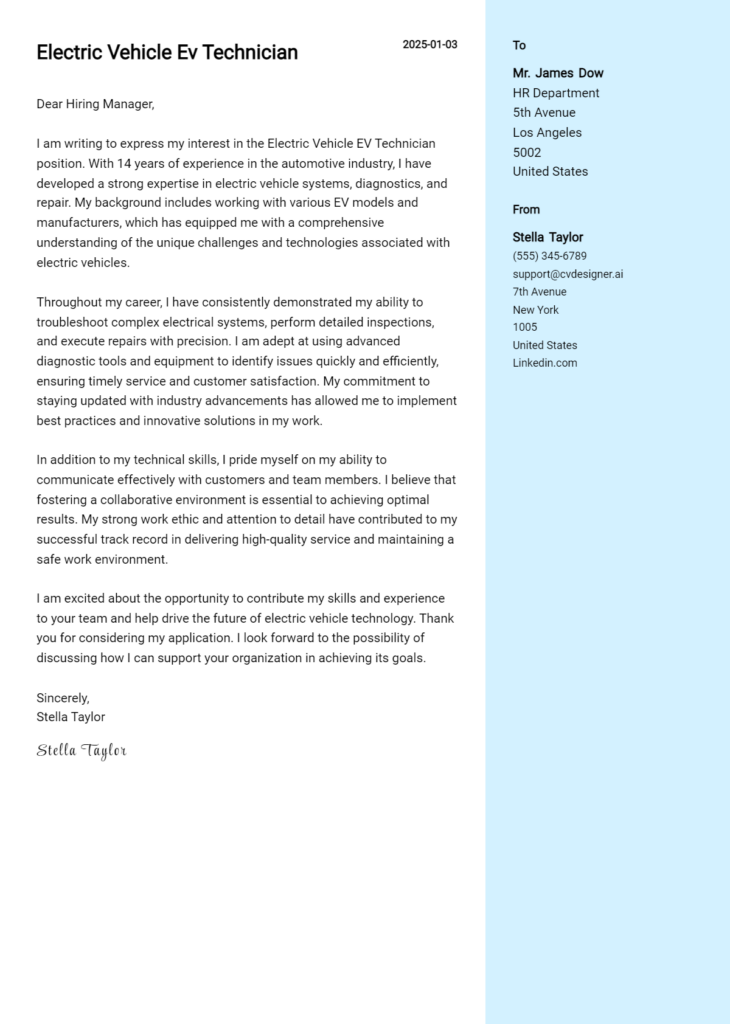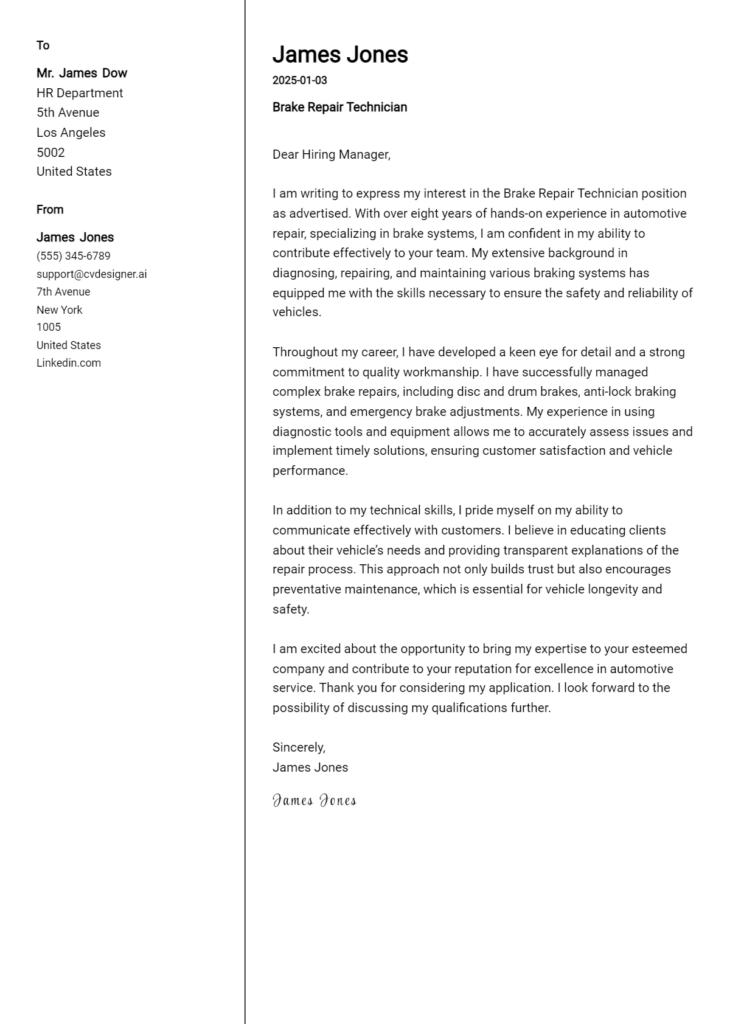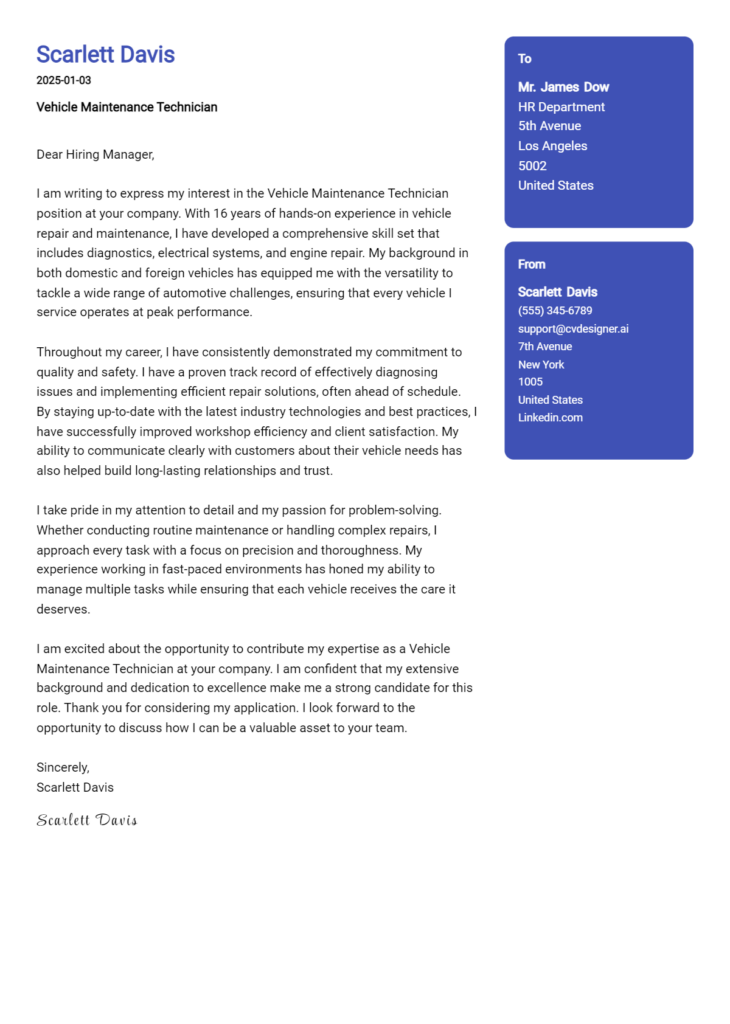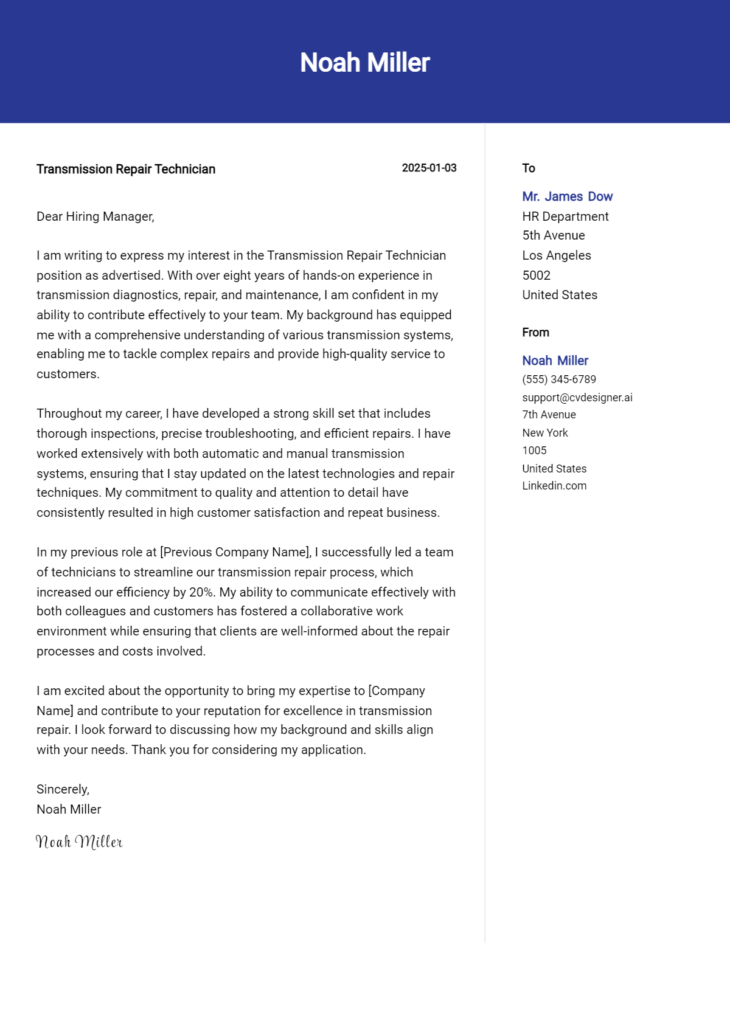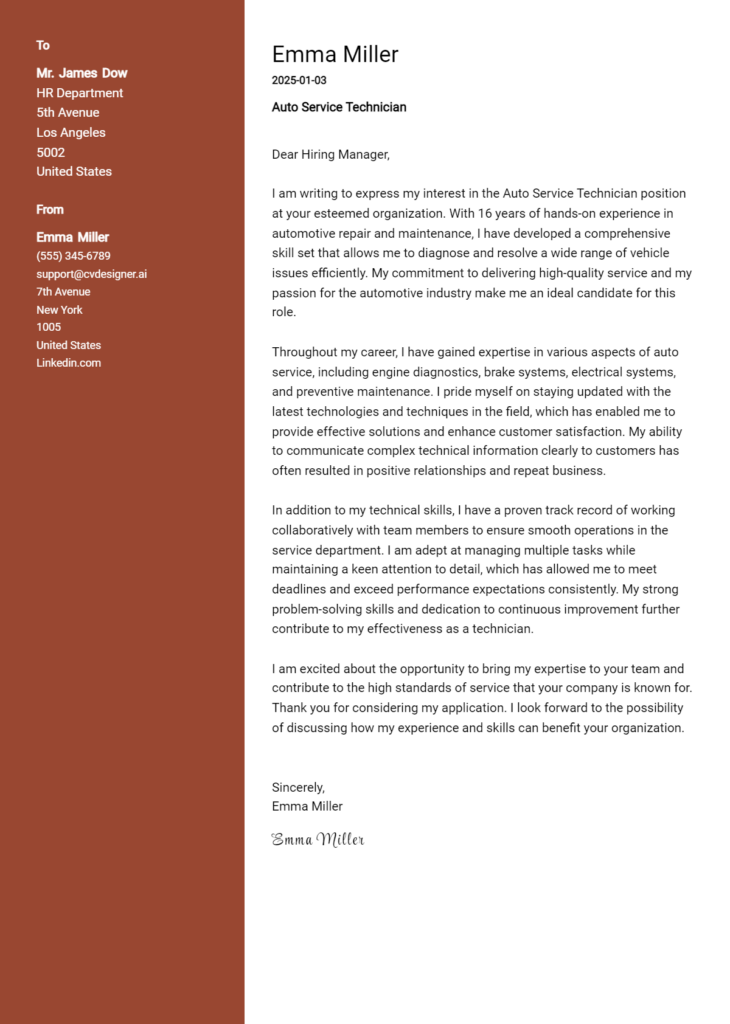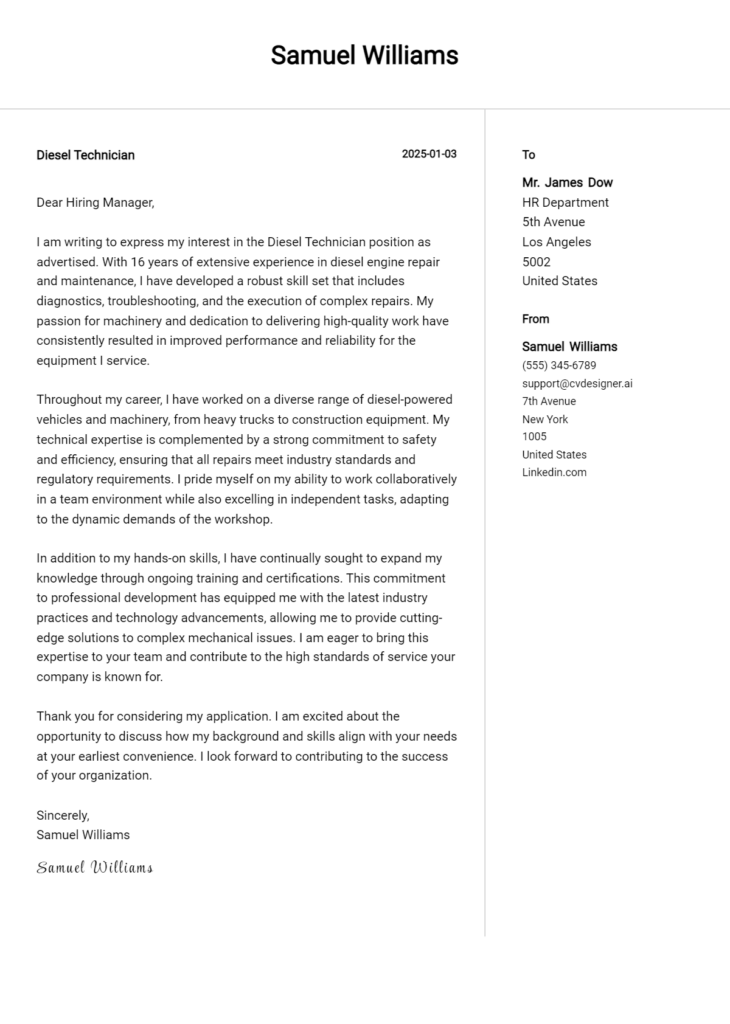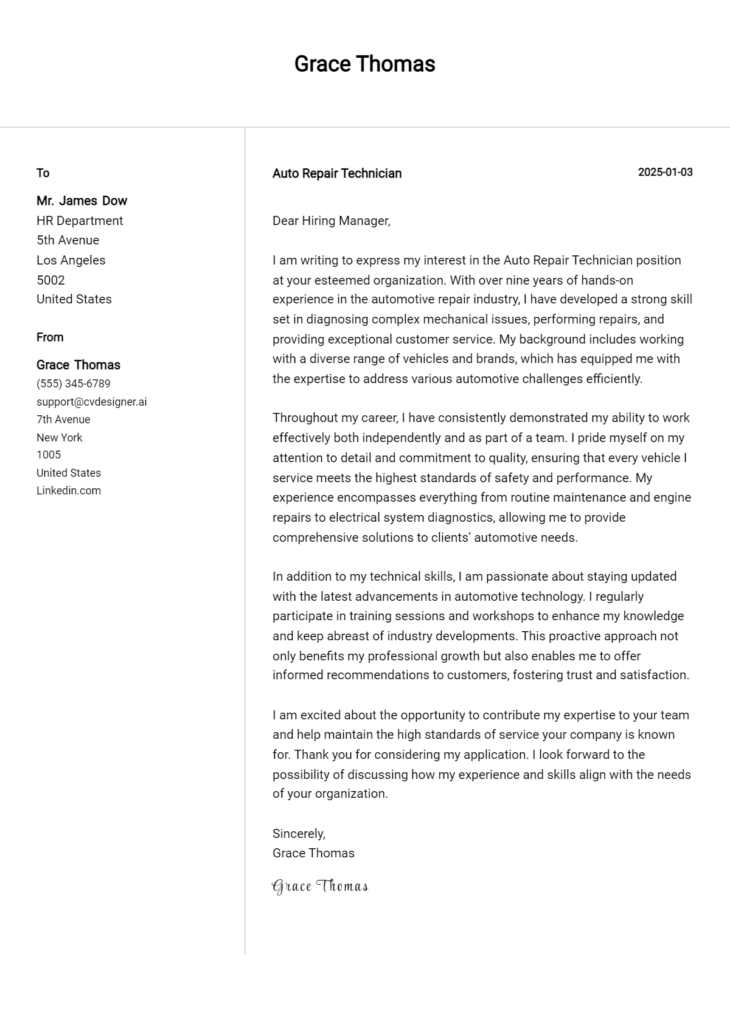Automotive Hvac Technician Cover Letter Examples
Explore additional Automotive Hvac Technician cover letter samples and guides and see what works for your level of experience or role.
How to Format an Automotive HVAC Technician Cover Letter?
Crafting a compelling cover letter is essential for an Automotive HVAC Technician, as it goes beyond simply listing your technical skills. The way you format and present your cover letter reflects your professionalism and attention to detail—qualities that are critical in the automotive industry. A well-structured cover letter not only captures the hiring manager's attention but also demonstrates your ability to communicate effectively, a vital skill when diagnosing and repairing complex HVAC systems.
In this guide, we will outline how to structure your cover letter, providing insights and automotive-specific examples to help you create a persuasive document.
We’ll focus on the crucial components of a professional cover letter, including:
- Cover Letter Header
- Cover Letter Greeting
- Cover Letter Introduction
- Cover Letter Body
- Cover Letter Closing
Each section plays a vital role in emphasizing your qualifications and commitment to the field. Let’s break down each part and explore how to make your Automotive HVAC Technician cover letter shine.
Importance of the Cover Letter Header for an Automotive HVAC Technician
The cover letter header is a critical component of any job application, including that of an Automotive HVAC Technician. It serves as the first impression for potential employers and sets the tone for the rest of the document. A well-structured header should include essential information such as your contact details, the date, and the recipient's details. Clarity and professionalism are paramount; a clean and organized header not only reflects your attention to detail but also makes it easy for hiring managers to reach out to you. Below are examples of a strong and weak cover letter header for an Automotive HVAC Technician.
Strong Cover Letter Header Example
John Doe 1234 Main St Anytown, ST 12345 (123) 456-7890 johndoe@email.com October 5, 2023 Hiring Manager XYZ Automotive Services 5678 Industry Rd Anytown, ST 67890
Weak Cover Letter Header Example
John D. 123 Main St Anytown 10/5/23 To Whom It May Concern
The Importance of the Cover Letter Greeting
The greeting of your cover letter is crucial as it sets the tone for the rest of your application. It serves as the first impression you make on the hiring manager, showcasing your professionalism and attention to detail. By addressing the hiring manager directly, you personalize your application and demonstrate a genuine interest in the position. Avoiding generic greetings, such as "To Whom It May Concern," can significantly enhance your chances of standing out in a competitive job market. If you don't know the recipient's name, take the time to research or reach out to the company to find out. This small effort can make a big difference in how your application is received.
Strong Greeting Example
Dear Ms. Johnson,
Weak Greeting Example
To Whom It May Concern,
The Importance of a Strong Cover Letter Introduction for an Automotive HVAC Technician
A well-crafted cover letter introduction is crucial for any job applicant, especially for an Automotive HVAC Technician. This opening paragraph serves as the first impression and can significantly influence the hiring manager's decision to read further. A compelling introduction should immediately capture attention, clearly express the candidate's enthusiasm for the position, and succinctly highlight relevant skills or noteworthy achievements. This not only sets the tone for the rest of the letter but also establishes the candidate's qualifications right from the start.
Strong Example
Dear [Hiring Manager's Name], I am excited to apply for the Automotive HVAC Technician position at [Company Name], as I have a deep passion for automotive systems and a proven track record of optimizing vehicle climate control. With over five years of hands-on experience in diagnosing and repairing HVAC systems in a variety of vehicles, I am adept at troubleshooting issues quickly and efficiently. My commitment to providing exceptional service has not only earned me recognition as a top technician in my previous role but has also resulted in a 30% increase in customer satisfaction ratings.
Weak Example
Hello, I am writing to apply for the Automotive HVAC Technician job. I have some experience fixing car air conditioning and heating systems, and I think I could do an okay job for your company. I like cars and hope to get a position soon.
Cover Letter Body for Automotive HVAC Technician
The cover letter body for an Automotive HVAC Technician serves as a crucial element in the job application process, providing a platform for candidates to articulate their specialized skills, relevant experiences, and the unique value they bring to a prospective employer. This section allows the applicant to detail specific projects or accomplishments that demonstrate their technical expertise and problem-solving abilities in automotive heating, ventilation, and air conditioning systems. By showcasing past achievements, such as successful installations, repairs, or troubleshooting experiences, candidates can effectively illustrate their qualifications and potential contributions to the company.
Strong Example
As an Automotive HVAC Technician with over five years of hands-on experience, I successfully led a project that involved retrofitting an outdated HVAC system in a fleet of delivery vans to meet new environmental standards. This project not only improved the energy efficiency of the vehicles by 20% but also significantly reduced operational costs for the company. My expertise in diagnosing complex HVAC issues, coupled with my certifications in refrigerant handling and system design, ensures that I can contribute effectively to your team and help elevate the quality of service provided to your customers.
Weak Example
I have worked as an HVAC Technician for a few years. I have done basic repairs and maintenance on cars. I think I would be a good fit for your company because I like working with cars and I am willing to learn more about HVAC systems.
Importance of the Cover Letter Closing for an Automotive HVAC Technician
The closing of a cover letter is crucial for an Automotive HVAC Technician as it provides an opportunity to summarize qualifications, reiterate enthusiasm for the role, and prompt the employer to take the next steps, such as reviewing the resume or scheduling an interview. A strong closing leaves a lasting impression, while a weak one may diminish the overall impact of the application. Below are examples of both strong and weak closing paragraphs.
Strong Example
Thank you for considering my application for the Automotive HVAC Technician position. With my extensive experience in diagnosing and repairing HVAC systems, combined with my certification in automotive technology, I am confident in my ability to contribute effectively to your team. I am excited about the opportunity to bring my skills to your esteemed company and would welcome the chance to discuss how I can help enhance your service operations. I look forward to the possibility of an interview and am available at your convenience. Please feel free to contact me to schedule a meeting.
Weak Example
Thanks for reading my letter. I hope you look at my resume. I’d like to work for your company if you think I'm good enough. Let me know if you want to talk.
These tips will help candidates craft an effective cover letter for an Automotive HVAC Technician position. A well-written cover letter is essential for making a strong first impression on potential employers. It should highlight your technical skills, problem-solving abilities, knowledge of the software development life cycle (SDLC), teamwork capabilities, and a passion for continuous learning. By emphasizing these areas, you can demonstrate your qualifications and commitment to the role.
Cover Letter Writing Tips for Automotive HVAC Technician
Showcase Your Technical Skills: Clearly outline your technical expertise related to HVAC systems. Mention specific certifications, tools, and technologies you are proficient in. Highlight any experience with system diagnostics, repairs, or installations. This not only shows your capability but also your familiarity with industry standards.
Emphasize Problem-Solving Abilities: Provide examples of challenging HVAC issues you have resolved in the past. Discuss your approach to troubleshooting and any innovative solutions you implemented. This illustrates your analytical skills and your ability to think on your feet, which is crucial in the automotive industry.
Demonstrate Knowledge of SDLC: If applicable, mention your understanding of the software development life cycle, especially if you've worked with automotive software systems. Explain how your knowledge can contribute to improving HVAC system integrations or enhancements, thereby showcasing your versatility in the field.
Highlight Teamwork and Collaboration: Describe your experience working in teams, whether in previous jobs or training environments. Mention any successful projects you contributed to and how collaboration led to improved outcomes. Employers value technicians who can work well with others and contribute to a positive work culture.
Express a Passion for Continuous Learning: Convey your commitment to ongoing professional development. Discuss any workshops, courses, or certifications you’ve pursued recently. This shows potential employers that you are proactive about staying current in your field and are dedicated to enhancing your skills.
For additional resources, consider using cover letter templates to structure your letter effectively, or try out a cover letter builder to create a polished and professional document tailored to your experience.
Common Mistakes to Avoid in an Automotive HVAC Technician Cover Letter
Crafting a compelling cover letter is essential for making a positive impression as an Automotive HVAC Technician. Avoiding common mistakes can significantly enhance your chances of landing an interview. Here are some frequent pitfalls to watch out for:
Generic Greetings: Using "To Whom It May Concern" can make your application seem impersonal. Instead, research and address the letter to a specific hiring manager or team.
Lack of Specificity: Failing to tailor your letter to the job can result in a missed connection. Highlight relevant skills and experiences that align with the job description.
Repetitive Content: Simply repeating your resume content can be redundant. Use your cover letter to expand on specific achievements and explain how they relate to the HVAC position.
Ignoring Formatting: A cluttered or unprofessional format can deter hiring managers. Adhere to a clean and organized cover letter format that enhances readability.
Spelling and Grammar Errors: Typos can undermine your professionalism. Always proofread your letter multiple times and consider using tools for grammar checks.
Neglecting a Strong Closing: Failing to include a compelling closing statement can leave the reader underwhelmed. Conclude with a strong call to action, expressing your eagerness for an interview.
Not Including Relevant Examples: A lack of specific examples can weaken your case. Use concrete instances from your experience to demonstrate your skills and contributions.
By steering clear of these common mistakes and referencing cover letter examples, you can create a strong and effective cover letter that showcases your qualifications as an Automotive HVAC Technician.
Cover Letter FAQs for Automotive HVAC Technician
What should I include in my cover letter as an Automotive HVAC Technician?
Your cover letter should highlight your relevant experience, skills, and certifications that pertain to HVAC systems in vehicles. Start with a strong opening that captures the employer's attention. Clearly outline your technical skills, such as knowledge of air conditioning systems, heating components, and diagnostics. Mention any certifications, such as EPA 608 or ASE certifications, to demonstrate your qualifications. Additionally, include specific examples of past work experience where you successfully diagnosed and repaired HVAC systems or improved service efficiency. Tailor your cover letter to align with the job description, showcasing how your expertise can benefit the company.
How can I make my cover letter stand out?
To make your cover letter stand out, personalize it for the specific job and company. Begin with a unique opening statement that reflects your passion for automotive HVAC systems. Use quantifiable achievements to demonstrate your impact in previous roles, such as “reduced repair time by 20%” or “increased customer satisfaction ratings.” Incorporate industry-specific jargon to show your familiarity with HVAC technology and practices. Lastly, express your enthusiasm for the role and the company’s mission, as a genuine interest can resonate positively with hiring managers.
Should I mention my previous employers in my cover letter?
Yes, mentioning your previous employers can be beneficial, especially if they are well-known in the automotive industry or if they relate to the position you're applying for. When referencing past employers, focus on your specific roles and accomplishments during your tenure. Highlight any relevant projects or responsibilities that demonstrate your HVAC expertise. However, be cautious not to disclose confidential information or speak negatively about past employers. Instead, frame your experience positively, showing how it has prepared you for the role you are applying for.
How long should my cover letter be for an Automotive HVAC Technician position?
Your cover letter should typically be one page long, consisting of three to four paragraphs. Aim for around 250 to 400 words to ensure it is concise yet informative. Focus on providing enough detail about your skills and experiences without overwhelming the reader. Each paragraph should serve a purpose: an introduction that captures interest, a middle section that outlines your qualifications and achievements, and a closing that expresses enthusiasm and invites further discussion. Keeping it brief and to the point will make a more significant impact on hiring managers.
Build your Cover Letter in minutes
Use an AI-powered cover letter builder and have your letter done in 5 minutes. Just select your template and our software will guide you through the process.


